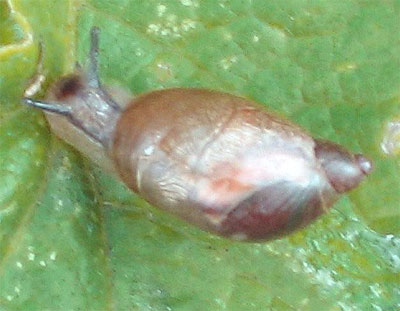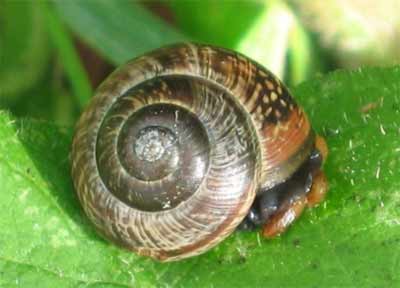Snail Mystery Solved!
By Ruth D’Alessandro, The Wildlife Gardener Did you know that snails can be amphibious? The Wildlife Gardener didn’t either until she received an email from snail specialist Janet Ridout-Sharpe, a freelance malacoarchaeologist and a member of the marvellously named Archaeomalacology Group. You may recall much scratching of heads over the identity of this snail found near a mill pond close to the Wildlife Garden:

Janet’s identification email is as follows:
I really hate to disappoint you in your hope for something new and exciting, but what you have photographed is a splendid example of Succinea putris, the ‘amber snail’ (so called because of the colour of its empty shell). This is a member of the Succineidae which are amphibious in habit – the five British species all live in moist places, such as water meadows and emergent vegetation along the banks of lakes and rivers. Your website says that you found yours near a mill pond. The shells are rather similar but fortunately, from the point of view of identification, Succinea putris is the only British species with a pale body. The dark lines running down the outside of the tentacles and the ‘neck’ are also indicative – there is a good coloured drawing of this snail in the FSC publication ‘Land snails in the British Isles
‘ (p.41 ,plate 3) and in Kerney and Cameron, ‘A Field Guide to the Land Snails of Britain and North-West Europe
‘ (p.65, plate 2), a dead ringer for your photo!
How fascinating that the Succineidae are amphibious – this would explain why they look like terrestrial snails in pond snails’ shells. But here Janet possibly poses another question that has The Wildlife Gardener off at a tangent scratching her head once again:’Succinea putris is the only British species with a pale body’. Here, Janet means that S. putris is the only member of the Succineidae family to have a pale body. But this made me think of another snail that has a pale body. On chalky downland walks we have often come across large Burgundy or Roman snails (Helix pomatia):

Roman snails were introduced to Britain by – you’ve guessed it – the Romans. Are they still considered an introduced species all these centuries later, and cannot be called British? How long does a creature have to be here for before it can be called a native? Is an introduced species ever a native? In the meantime, The Wildlife Gardener can only share with Naturenet readers a picture of another very pretty snail (Arianta arbustorum) found alongside the amber snails, and dream of the day when I submit an article to the Archaeomalacology Group Newsletter.

- Spurn Spawn! - 26th February, 2014
- Bluebells on wheels: axles of evil? - 2nd February, 2011
- Raising the ba: Wildlife and the Ancient Egyptian Book of the Dead - 8th January, 2011
